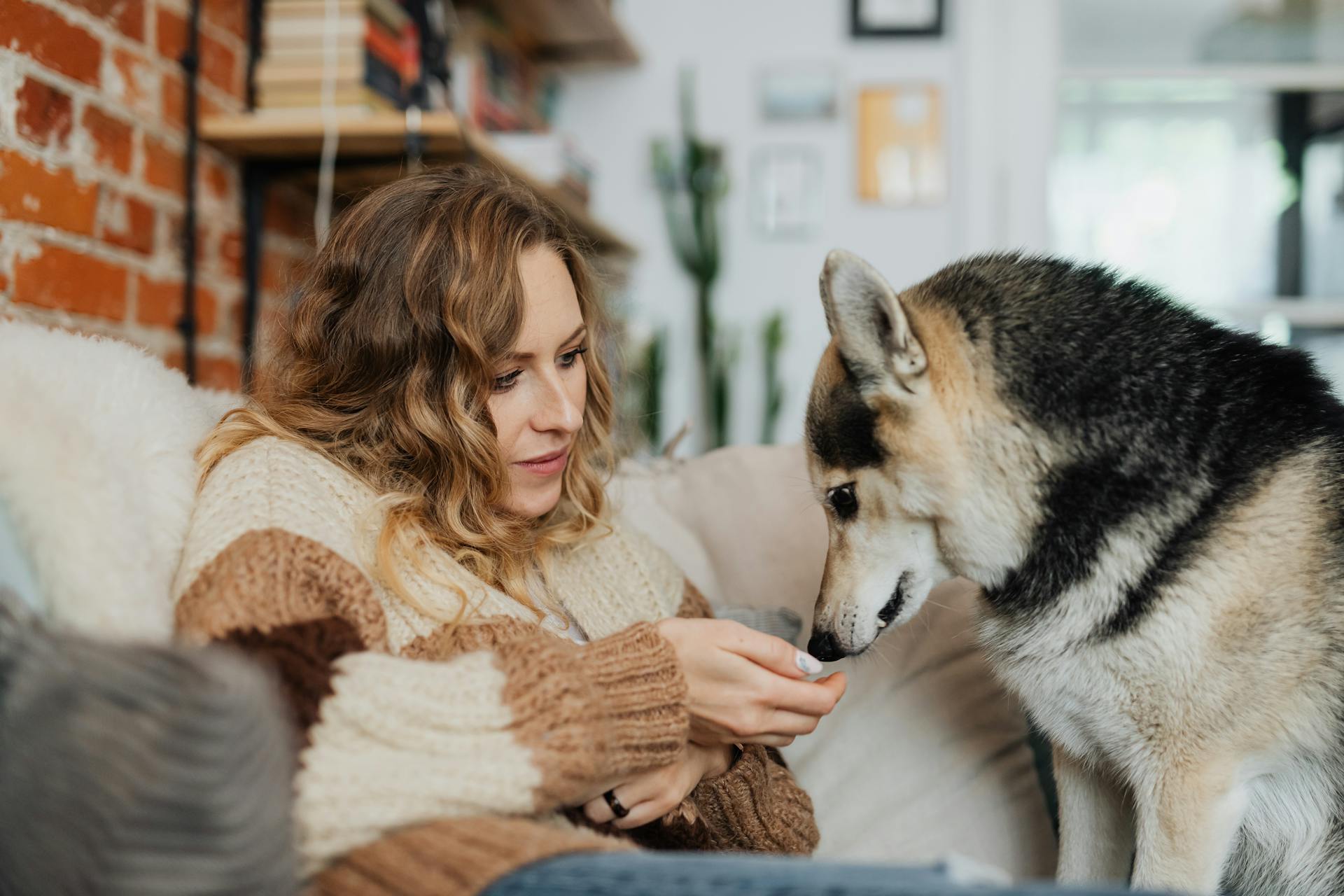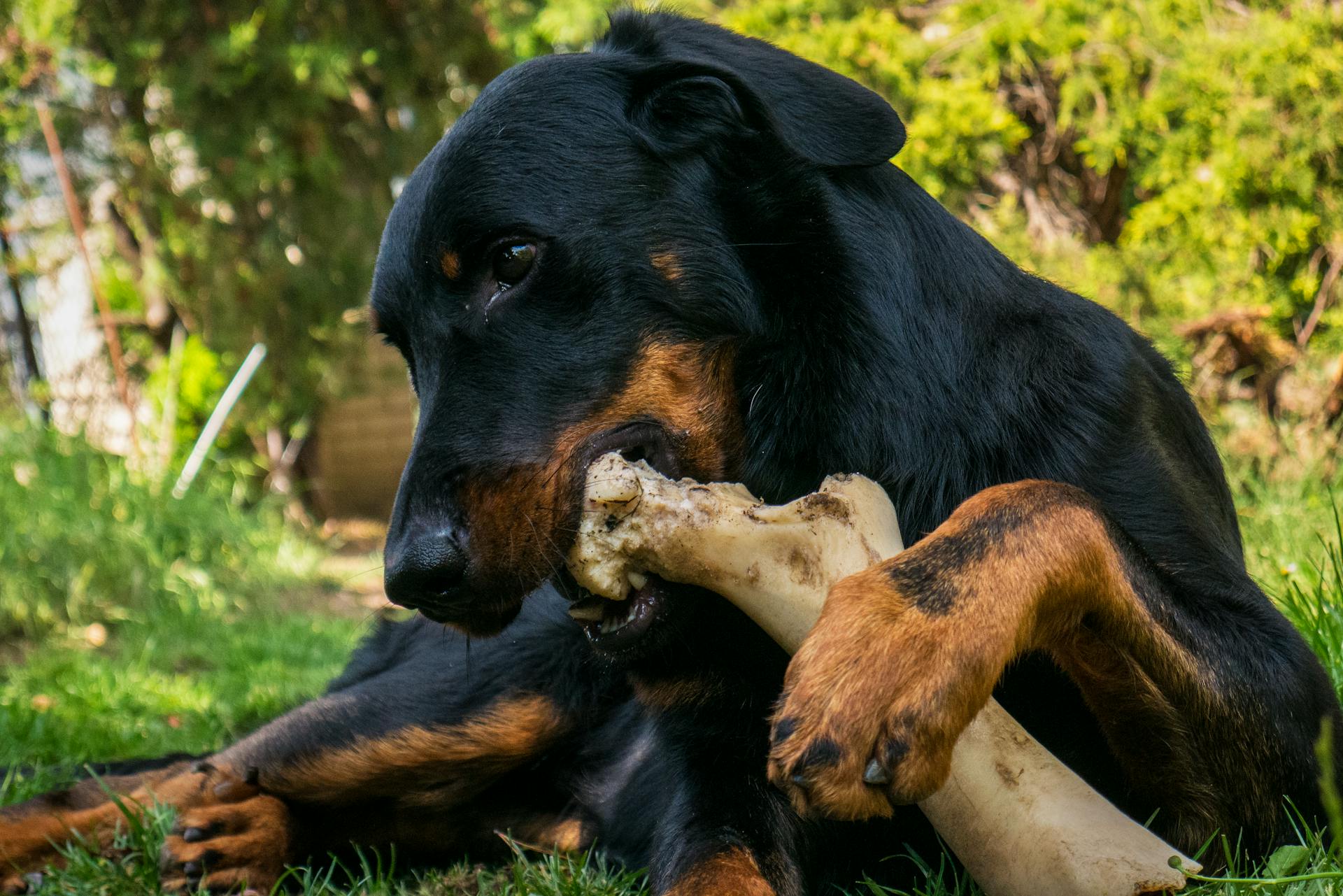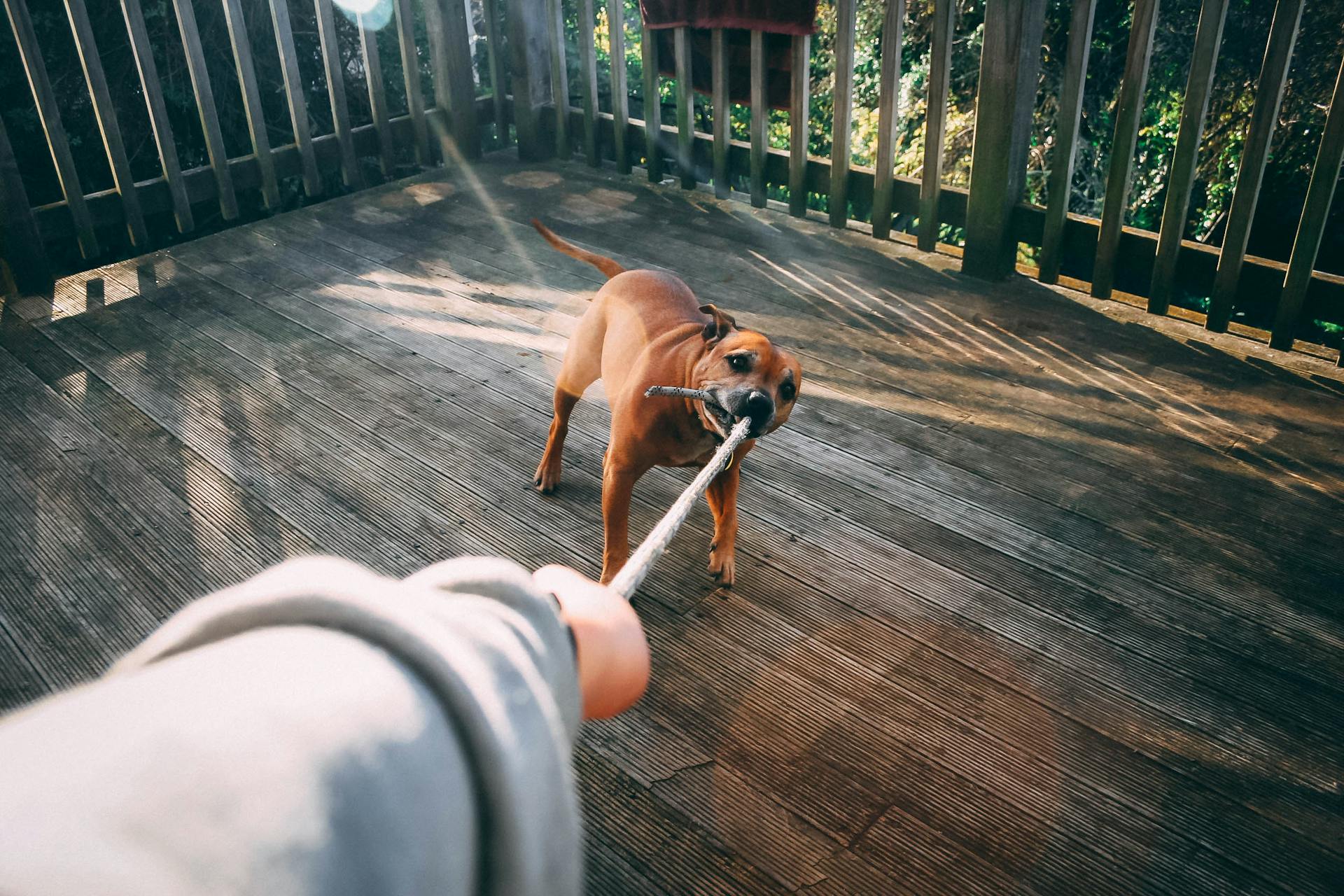
Disciplining a dog for biting requires a calm and patient approach. According to experts, yelling or punishing your dog can actually make the problem worse, as it can create anxiety and fear.
To start, you need to understand why your dog is biting in the first place. Common reasons include resource guarding, fear, or overexcitement. Identifying the underlying cause is crucial to effective discipline.
A key part of discipline is redirecting your dog's behavior, rather than simply punishing them for biting. This can involve teaching alternative behaviors, such as a "gentle" or "leave it" command.
Redirecting your dog's behavior can be as simple as swapping out a toy that's being aggressively mouthed for a new one. This helps to refocus your dog's attention and redirect their energy.
Additional reading: Dog Fear Aggression Training
Understanding Puppy Behavior
Puppies are naturally playful and can be troublesome, so it's essential to understand their behavior to correct common problems before they become too late.
Puppies nip and bite to entice play, learn bite inhibition, and explore their surroundings. They may also chew on everything, including you and your clothes, while teething.
Some puppies may learn to soften their bite through play sessions with other puppies, but others may need multiple sessions to learn this important skill. Your puppy will try to engage in play by biting you because it's a normal dog behavior.
To curb your puppy's biting and nipping, you need to understand why they're doing it in the first place. This largely depends on the reason behind their behavior, and it's essential to respond accordingly.
On a similar theme: Puppy Shock Collar
Why Puppies Bite
Puppies bite as a normal part of their play and exploration of the world. It's how they learn about their environment and develop social skills.
They also chew on everything, including people and clothes, while they're teething. This is a natural process that helps them discover the taste and consistency of different objects.
Puppies nip or bite to entice play, and through this behavior, they learn bite inhibition. They figure out how much pressure they can apply with their teeth and what happens when they bite too hard.
If a puppy bites too hard and causes pain, the other puppy will cry out and refuse to play. This teaches the biting puppy to soften their bite, as they learn that biting too hard ends the play session.
Some puppies learn to soften their bite in just one play session, while others need multiple interactions with different puppies to learn this important skill.
Related reading: Puppy Mill Dogs Behavior
Puppy Biting
Puppy biting is a normal behavior, but it can be challenging to deal with. Puppies naturally nip at each other while playing, and this helps them learn bite inhibition.
It's essential to teach your puppy that biting means "game over" and to redirect their attention to a toy instead. If your puppy bites you while playing, that means playtime is over, with no exceptions.
If this caught your attention, see: Shock Collar for Biting Puppy
You can use a calming signal like tucking your hands into your armpits to let your puppy know that biting is not acceptable. This minor form of attention withdrawal can help your puppy understand that biting will get them nothing.
Puppies also chew on everything, including you and your clothes, while they are teething. To redirect their biting, offer a toy instead of your hand or furniture.
Some puppies nip or bite to entice play, and this is a normal part of their socialization. If your puppy bites to start play or during play and will not be redirected to a toy, immediately get up and remove yourself from the puppy's area.
It's also essential to give your puppy a wide variety of puppy toys to chew on and to pick up other household items within their reach that they shouldn't chew on.
For another approach, see: Tug of War Toy for Dogs
Dog Bite Classifications
Ian Dunbar, a well-known veterinarian, dog trainer, and behaviorist, has developed a six-level system of classifying bites to make discussions of dog biting behavior more consistent and understandable.
The system is designed to help us recognize the seriousness of a dog's intentions and take action to prevent further biting.
Tooth contact on skin but no puncture is classified as a Level 2 Bite, which is a warning sign that the dog is serious about biting.
This level indicates that the dog wanted to bite but didn't break the skin, and it's essential to remove the dog's stressors at this point to prevent the behavior from escalating to the next level.
A unique perspective: What Is the Purpose of Biting a Dog's Ear?
Correcting Biting Behavior
Correcting biting behavior is key to preventing it from becoming a habit. Yelling at or physically punishing your puppy can actually make them fearful of being handled and teach them that biting gets a response from you.
Teaching your puppy that biting means "game over" is a more effective approach. If your puppy bites you while playing, immediately end playtime and remove yourself from the area for about 30 seconds. When you return, get a toy and resume play.
To teach your puppy bite inhibition, you can make a high-pitched "ow!" sound if they bite you, but be aware that this might not work for every puppy. Instead, calmly turning around and walking away is often a more effective way to discourage biting.
Stopping Puppy Biting
Stopping puppy biting is crucial for a harmonious relationship with your furry friend. You can teach your puppy that biting means "game over" by turning around and tucking your hands into your armpits.
Puppies bite for various reasons, including play behavior, teething, and to entice play. They learn bite inhibition by playing with littermates and other puppies, who will yelp if bitten too hard.
To stop your puppy from biting to play, remove yourself from the situation and return with a toy when calm. This teaches your puppy that biting doesn't get a reaction from you. Be careful not to roughhouse with your puppy, as this can encourage biting.
If your puppy bites to start play, immediately get up and remove yourself from the area. Remain out of the area for about 30 seconds before returning with a toy. This helps your puppy understand that biting doesn't initiate play.
Puppies also bite due to teething and exploration. They may continue to bite if they receive positive feedback, such as a reaction from you. To stop this behavior, provide a variety of chew toys and redirect your puppy to these when they bite on inappropriate objects.
If this caught your attention, see: How Do You Discipline a Dog That Doesn't Listen
Teaching your puppy bite inhibition is essential. You can do this by making a high-pitched "ow!" sound if they bite too hard, or by calmly removing yourself from the situation. Reward your puppy with treats and praise when they exhibit gentle behavior.
By providing an alternative item to chew, such as a puppy toy, you can redirect your puppy's biting behavior. If they continue to nip, stop the play session immediately and redirect them to a toy. This teaches your puppy what is acceptable to bite or chew.
Level 2 Bite
A Level 2 Bite is a warning sign that your dog is serious about biting. This is a critical moment to address the issue, as it's a clear indication that your dog is eager to bite but hasn't yet broken the skin.
The dog is simply looking for a way to express its frustration or anxiety, and it's up to you to identify and remove the stressors that are causing this behavior. A tooth contact on skin but no puncture is a clear warning sign that your dog needs attention.
Removing the stressors at this point is crucial, as it can prevent the situation from escalating to a more serious bite. This might involve separating the dog from the source of stress, providing a calm and safe environment, or redirecting its attention to a more positive activity.
For another approach, see: Lump under Skin after Dog Bite on Human
Providing Alternative Solutions
Keep a puppy chew toy at hand to anticipate biting behavior and substitute the toy for your hand or furniture, letting pups know what is OK to bite or chew.
If your puppy starts nibbling at your fingers or toes while playing, offer a toy instead. If they continue to nip, stop the play session immediately.
You can also teach your puppy bite inhibition by making a high-pitched "ow!" sound if they bite you, but be aware that this might get them even more worked up and likely to bite.
Teething
Your puppy's teething phase can be a challenging time, but understanding what's happening can help you provide the right solutions. At around 12-16 weeks old, adult dog teeth start to grow in, causing sore gums.
This can lead to increased chewing on objects, including you, your clothes, and even your hair. Puppy biting tends to peak around 13 weeks old.
During this time, it's essential to provide your puppy with plenty of chew toys to redirect their attention. This can help save your furniture and your hair from becoming a chew toy.
Worth a look: Will Neutering a Dog Stop Aggression
Provide Puppy Chew Alternative
Providing a puppy with an alternative chew item can be a lifesaver for both you and your furry friend. Keep a puppy chew toy on hand at all times to anticipate biting behavior and substitute it for your hand or furniture.
It's essential to offer a toy instead of your fingers or toes when your puppy starts nibbling. This teaches them what is okay to bite or chew.
If your puppy continues to nip, stop the play session immediately. This sends a clear message that biting is not acceptable.
If your puppy is biting during play, that means playtime is over, with no exceptions. Yelling or physically punishing your puppy is not an effective solution, as it can make them fearful of being handled.
Instead, try turning around and tucking your hands into your armpits. This is a calming signal and a minor form of attention withdrawal that can help your puppy understand that biting gets them nothing.
By providing a variety of puppy toys and redirecting your puppy's attention to them, you can curb their biting and nipping behavior.
Teaching Consequences
Teaching consequences is a crucial part of disciplining your dog for biting. To do this, you need to be consistent in your response. Discipline your puppy the same way every time, no matter the time or place.
If your puppy bites you while playing, that means playtime is over, with no exceptions. Turning around and tucking your hands into your armpits is a calming signal and a minor form of attention withdrawal. This teaches them that biting will get them nothing.
Be Consistent
Consistency is key when teaching consequences to your puppy. It's essential to discipline your puppy the same way every time, no matter the time or place.
If you punish your puppy for barking at the neighbors on Tuesday but let it slide on Wednesday, they'll be confused and won't learn the desired behavior. This inconsistency can lead to a lack of understanding of what's expected of them.
Discipline should be a clear and consistent signal that a behavior is not allowed. This helps your puppy learn faster and reduces the likelihood of them developing bad habits.
Turning around and tucking your hands into your armpits when your puppy bites you is a great way to teach them that biting gets them nothing. This calming signal and minor form of attention withdrawal can help prevent biting in the future.
By being consistent, you'll help your puppy understand what's expected of them and reduce the risk of confusion and bad behavior.
Additional reading: Will Spaying a Dog Help with Aggression
Time-Out
Using a time-out is a great way to teach your puppy that biting is not acceptable behavior. This technique helps them calm down and learn that biting gets them nothing.
If your puppy bites you while playing, you can gently put them in their crate to give them a chance to calm down. This is especially helpful if they're in a state of overexcitement or frustration.
It's essential to make sure the crate doesn't become associated with punishment. So, be calm and gentle when putting your puppy in the crate. This will help them understand that the crate is a safe space for them to calm down.
Once your puppy has calmed down, you can let them out of the crate.
On a similar theme: When Do Labradors Calm down
Teaching Puppy Biting Consequences
Teaching your puppy to understand that biting means "game over" is crucial. According to Kathy Santo, a dog trainer and columnist for AKC Family Dog, turning around and tucking your hands into your armpits is a calming signal and a minor form of attention withdrawal.
You should never yell at or physically punish your puppy for biting, as this can actually teach them that biting gets a reaction from you, which is known as positive punishment.
Puppies naturally nip at each other while playing, but if they bite too hard, the other dog will likely make a loud yelp sound, warning the puppy to ease up.
If your puppy bites you while playing, that means playtime is over, with no exceptions. You should immediately stop the play session.
Making a high-pitched "ow!" sound if your puppy bites you can actually get them even more worked up and likely to bite, so it's better to turn quietly around, walk away, or gently put the pup into their crate for a few minutes to calm down.
You might like: Sound Bite
Rewarding your puppy with a treat and some verbal praise when they back off after biting is a great way to reinforce good behavior.
Some dog owners use a bitter spray to deter puppies from chewing and biting on objects, but this method may not be effective for all puppies.
Puppies learn bite inhibition by experiencing the consequences of biting too hard, such as a loud yelp from their mother or littermate.
Level 4 Bite
A Level 4 Bite is a serious indication that your dog has lost control and needs to learn about consequences. This level of bite is characterized by one to four holes, deep black bruising with punctures deeper than the length of the canine.
The punctures are typically deeper than the length of the canine, indicating that the dog bit and clamped down. This level of bite is a clear sign that your dog needs to learn about gentle behavior.
The presence of slashes in both directions from the puncture is another indicator of a Level 4 Bite, suggesting that the dog bit and shook its head. This level of aggression requires immediate attention and correction.
For more insights, see: Dog Training Quadrants
Sources
- https://theanimalrescuesite.com/blogs/news/how-to-discipline-a-puppy
- https://www.akc.org/expert-advice/training/stop-puppy-biting/
- https://www.petmd.com/dog/training/puppy-biting
- https://www.whole-dog-journal.com/behavior/what-to-do-when-your-dog-bites/
- https://www.thinkingoutsidethecage.org/pet-resources/behavior-help/dog-behavior-help/growling-and-snapping-2/
Featured Images: pexels.com


